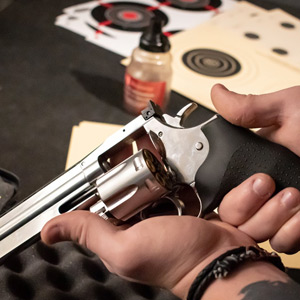When choosing an air gun, where you’ll be able to safely practice shooting plays a major role in your decision. While smaller airguns can be shot indoors in areas like sheds, garages, basements, attics, and more, some air rifles demand more space to account for their greater firing power. With the ability to break the sound barrier, powerful air rifles should be shot outdoors where shooters can safety distance themselves from targets and prioritize safety for those around them. There are several key differences between a high-power air rifle range and an indoor airgun range. We’ll break down these differences, highlighting the importance of each. This discussion boils down to one of safety – for the shooter, other shooters, bystanders (should they be watching), and pets. Complacency on safety can lead to serious injury, which we must avoid at all costs. Here is all that you need to know about these types of airgun ranges. If you plan to build your own, we also delve into the essentials when setting up an airgun range.
Air Rifles Ranges
Because air rifles can be incredibly powerful, they’re best used outdoors if not in a professional-run indoor range. During the winter, practicing outside can become a challenge, which is why there are clubs that riflemen can join. These ranges can likely be found in your area, where you’ll shoot in a lane anywhere between 30 to 80 feet. Otherwise, for the safety of yourself and others, we recommend using air rifles in outdoor ranges designed for them. The last thing you want to do is set up a range in your home or other indoor space, and then damage your walls with pellets.
If you’d like to set up your own outdoor air rifle range on your property, it’s fairly easy to do once you know the right types of targets to use, reliable backstops, and overall distance parameters. To begin, ensure you have a nice berm to act as a safe area for pellets to land. Don’t rely on trees or walls of buildings! If there is not an earth berm already in the space, create one. Another important factor here is to ensure you know the exact distance to every target you install in your air rifle range. Guesswork leads to disorder, which should not be present whatsoever in the range. There should also be enough distance between you and the targets, as well as on the sides of the range in preparation for ricocheted pellets. This should be about 50 yards or so between you and the targets, and 20 or so yards on the sides of the range. Keep those in and around your air rifle range away from the downrange area! Just because you aren’t dealing with lead bullets does not mean that injury is of no concern. Ricocheted pellets can cause damage beyond the bounds of your range. Unlike an indoor range, your shots are not 100% guaranteed to stay within your designated area, so maintain constant safety precautions while the air rifle range is in use. If you’re feeling unsure about your air rifle range, give your local police department a call to have them come out and certify it.
Indoor Airgun Ranges
Aside from the change of scenery, there are an array of differences between an outdoor air rifle range and indoor airgun range. One of the best things about indoor airgun ranges is that they can be used essentially any time, as the weather has no effect on them. There are tons of official indoor airgun ranges nationwide that you can get quality practice in year round. Don’t want to join a club to shoot? Many folks choose to create their own indoor airgun ranges, and you can too with the right sized space.
The space, whether you’re using a garage, shed, basement, or other location, should be large enough that there is about 10 meters from the air gun’s muzzle to the target for pellets (20 feet for BBs). Just as with outdoor air rifle ranges, keep the downrange area and the sides clear of other shooters and those watching. The enclosed area presents different kinds of safety dangers. Like outdoor ranges, ricocheting pellets can be a major problem without the proper kind of targets. Use BB or pellet traps to prevent ricocheting altogether, and a backer board to protect the space’s walls from damage. Without the right targets, your ammo can easily ricochet back and potentially injure you and others. If your pellet airgun can reach 800 FPS, then lead dust becomes an issue. Because of this, try to use lead-free ammunition to keep lead dust low. After all, you’re shooting in a confined space and don’t want to breathe that in. Otherwise, keep firing speeds below 600 FPS for indoor shooting so the lead pellets don’t fragment. Getting your practice in shouldn’t mean you damage your health! Indoor airgun shooting can be tons of fun, and with the proper range setup, you’ll enjoy a great time by yourself or with friends and family in your very own space.
Bottom Line on Outdoor and Indoor Air Gun Ranges
While the needs for each type differ, the safety precautions are very much the same. While you can easily join indoor or outdoor air gun clubs, you don’t necessarily have to. For personal use ranges, determining the correct distances, types of targets, and downrange safety will ensure great shooting sessions. While it goes without saying, eye and ear protection are a must for each type of range. You can find protective gear, air gun targets, backer boards, and everything else needed for ranges here at Airgun Depot.
